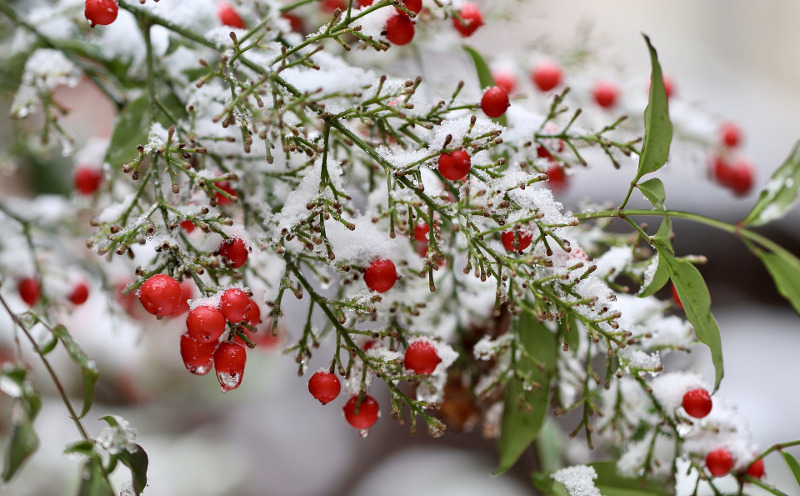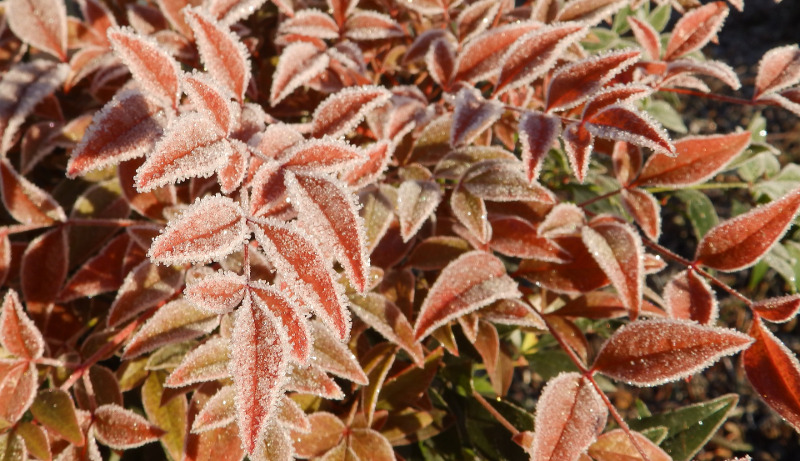Nandina are deciduous shrubs that the U.S. Department of Agriculture rates as cold hardy in zones 6 through 9. They should survive winter winds and frosts easily in those zones, assuming weather continues to fall within expected temperatures.

In zone 5, Nandina would benefit from (or require) some extra protection. Examples of this are being bundled in frost cloth, topped with mulch, or being grown up against a sunny wall. The colder the temperature is in your garden from the preferred growing zones, the more dieback you may see on your Nandina shrub. And it may not come back in the spring if it dies back too far.
Cutting Back Nandina for Winter
Being deciduous, Nandina will lose their leaves once winter temperatures arrive. You should not need to do much, if any, cutting back of your Nandina to prepare for winter. The best time to prune them is late winter, before spring growth begins.
Nandina Winter Care in Pots
How much winter care your potted Nandina requires depends on your microclimate and weather, as well as the pot you are using.
If you are growing in the warmer areas of Nandina’s range of zones 6-9, you are less likely to encounter lengthy freezes, in which case, you may be fine growing in smaller pots that are more vulnerable to cold.
However, if you are growing in zones 6-7, or if you are pushing the borders in zone 5, you’ll want to make sure you protect the Nandina’s roots. You can: plant in a frost-proof pot, with several inches of soil around the plant’s root ball to help insulate it, mulch the surface with bark chips, straw, or garden trimmings, wrap the pot in breathable fabric like frost cloth, and bring the pot up against a sunny wall.
Watering Nandina in Winter
Nandina do not enjoy having “wet feet,” which is a risk in certain areas with very rainy winters, or when growing in moisture-retentive soil, like clay. In those cases, consider moving your potted Nandina under a roof eave, or mulching with pebbles to deflect excess water. It’s important to make sure Nandina gets some water through the winter, but not too much.
In most climates, winter rain and snow supply sufficient water for Nandina, unless your plant is sheltered under an evergreen tree or potted and under the eaves, as mentioned above – then occasional watering every week or two is needed.
Another tip is if a frost is expected, and your plant is in a pot, or still getting established in the first two years in your yard, soak the plant well before the frost. This will protect the roots from freezing.

Growing Nandina Indoors
Nandinas are not suitable for indoor growing. As a woody plant that is accustomed to cool night temperatures and chilly winters, Nandina would not enjoy living in typical homes which maintain a constant range of about 60-75 degrees Fahrenheit.
Steps to Care for Nandina in Winter
Nandina need good drainage and a moderate amount of water over the winter. They do not need pruning in fall and should need little weather protection if grown in-ground in zones 6-9. Pots may need extra care; see above for full details.
Step 1 - For in-ground Nandina, take the opportunity to add compost and/or mulch in fall. For potted Nandina, mulch and consider wrapping pots in frost cloth or pulling pots against the house in colder zones.
Step 2 - Take care to check that the soil is not overly saturated – consider mulching clay garden soil with pebbles or moving pots under the eaves of the house.
Step 3 - If a sudden frost is expected, watering well before the frost hits will help protect your Nandina.
Step 4 - Water less than in the growing season – perhaps weekly or every other week – unless rain is scarce. Don’t let small pots or newly established plants dry out completely.
Step 5 - In late winter, consider if renewal pruning – removing 1/3 of the branches completely – or moving the plant is necessary.
 |
Author Maureen Farmer - Published 11-15-2021 |
